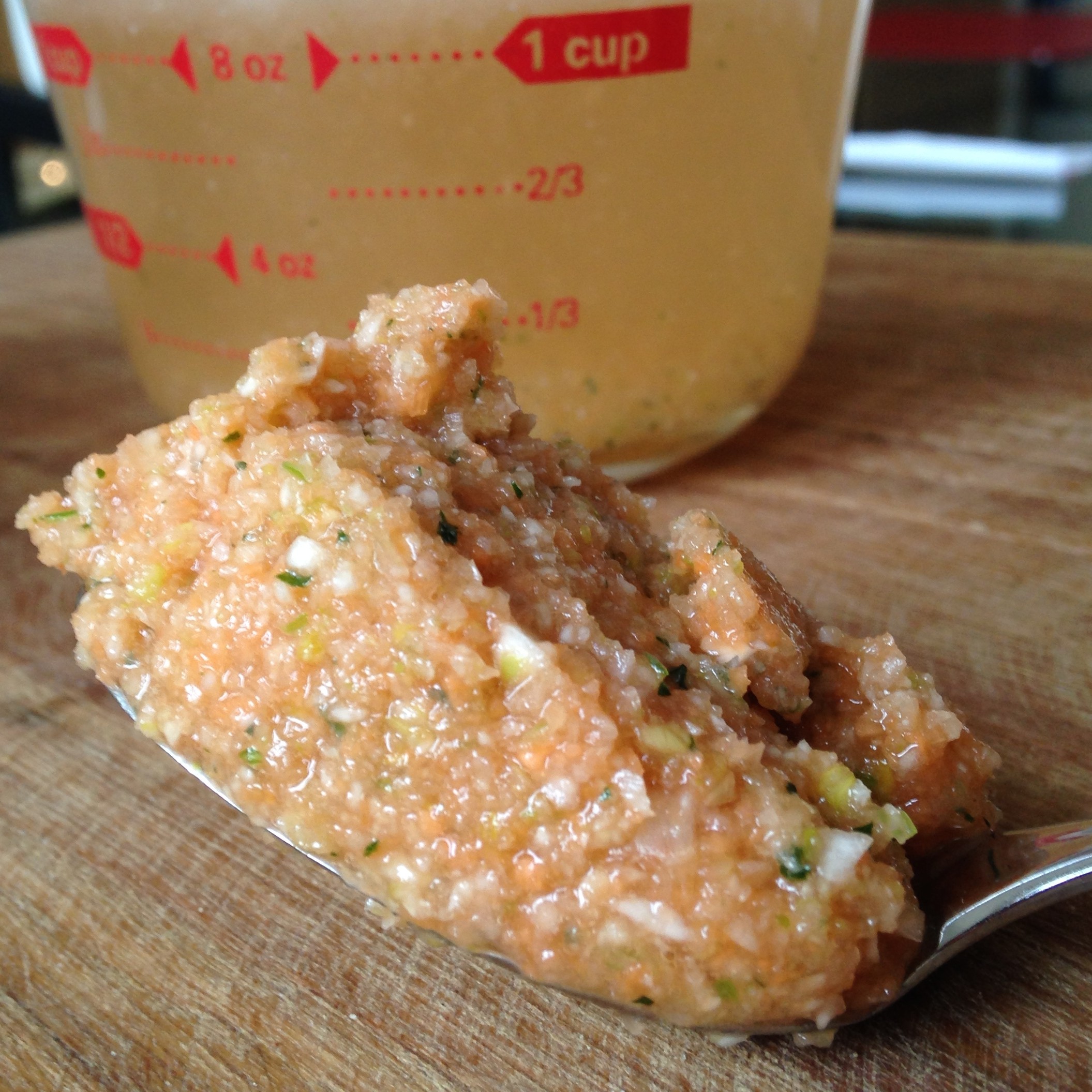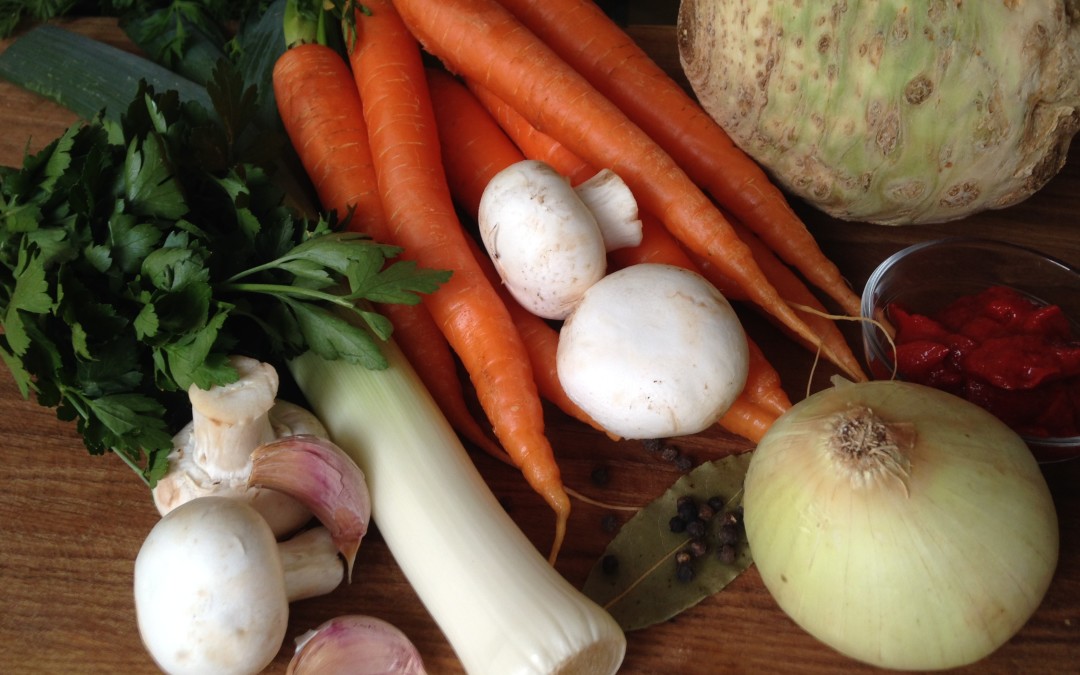We have discussed it many times before. When we build our dishes on solid, flavourful foundations, they come out more delicious. There is no greater foundation for dishes than a good stock – the flavorful elixirs that carry the essence of the ingredients used to make them. Chicken stock and beef stock are probably most used in recipes, but in this flexitarian world, how to make vegetable stock is equally important. The nuances of flavor that a good vegetable stock can bring to cooking vegan or vegetarian dishes (or any dishes for that matter) will make the difference between a good dish and a great one. Yes, I have said it many times, in a pinch the canned stuff is ok, but it won’t compare to a fresh, homemade stock.
Making a vegetable stock is easy. As with other stock, simmering ingredients in water is really all it takes. It is choosing the vegetables and aromatic herbs that can be a challenge. But in truth it is not. For vegetable stock, it needs to be kept simple with flavors that can be used in a broad spectrum of dishes. For example – some stock recipes call for rosemary or thyme, but these would not necessarily be a welcome flavor broadly. Sure, I like the flavor of rosemary and thyme, but it may not be best in my soup or sauce. If I want these flavors, I can always add it later when cooking. When we think of universal vegetables and aromatics, we can simply take a page from other stocks – leek, onion, celery, carrot, bay leaf, parsley, and peppercorn are all pretty standard. The addition of a little turnip or parsnip would be fine, too. These flavors are pretty safe. We do want our stock to bring a little extra to our dishes, though. Chicken and beef stock bring flavor by donating proteins to the mix. Since there is little protein in vegetables, we need to think of another source of helpful flavors that will be a complement to our dishes. It is the other taste – umami – that we need. To boost our umami, we can consider tomato with tomato paste being a good option as it has tons of umami in very little volume. We don’t want to add too much so it tastes like tomato, but enough to get the added flavor punch. Also, the less water we add, the better. Less water helps concentrate flavors. We can also add some mushrooms for umami, too. In a quest to reduce more water – the use of celery root instead of celery stalks is also good – lots of celery taste, but less water. It is also just slightly sweeter than the stalks.
The Vegetable Stock Ratio
The first tier tastes are leek, carrot, and celery (from celery root). These are in the stock in equal parts. Onion, mushrooms and turnip are added at half the amounts of the first three. It is worth noting that using sweet onions is a good idea. They add a little nuance and let the leek apply the alum (fancy word for the sulfur flavors that come from the onion family) flavors with the garlic. The aromatics, the parsley, peppercorns and 2 garlic cloves are enhancers so there won’t be that much in there. Just enough tomato paste is added to cover the vegetables in a thin layer. As with other stocks, the vegetables are simmered in just enough water to cover. A vegetable stock is subtle, so less water is more flavor.
How to Make Vegetable Stock – Recipe
- 1/2 lb of celery root
- 1/2 lb of carrots
- 1/2 lb of leeks – the whole leek can be used.
- 1/4 lb of sweet onion (like vidalia)
- 1/4 lb of white button mushrooms. (optional)
- 1/4 lb of turnips (optional)
- 1 bay leaf
- 1 small bunch of parsley
- 10 peppercorns
- 2 cloves of garlic
- about 2-2.5 tbsp tomato paste
- olive oil
- 4 cups of water
- Peel and clean the celery root, carrots, turnip, and onion.
- Clean the leek and mushrooms.
- Slice the leek into medium slices about 1/2 inch wide.
- Dice the celery root, carrot, turnip and onion into medium sized dice.
- Quarter the mushrooms.
- Place the vegetables in a large bowl. Toss with tomato paste until just coated.
- In a large pot, heat 3 tbsp of olive oil. Add the coated vegetables and cook until soft without colour about 10 minutes.
- Add the rest of the ingredients to the pot. Add enough cold water to cover.
- Bring the pot to a gentle simmer. Simmer for an hour to an hour and a half.
- Strain the stock. Let cool. Make 1 or 2 cup allotments and store in the freezer or refrigerator.
- Any vegetable scraps you have can certainly be thrown in. I am wary about scraps that are not in very good shape as any bad flavors from bad scraps will end up in the stock.
- If you are concerned about waste (and we should all be concerned about waste), the left over vegetables after cooking the stock can be pulsed in a food processor into a paste and put in the freezer. This makes a fine extra addition to dishes as needed. You could also put them in a vegetable soup with some extra fresh vegetables. If you are going to use them, it is best to tie up the aromatics in some cheese cloth so they are easy to get out of the pot.
- The cooking in olive oil (see recipe) is optional. It helps take some of the rawness out of the vegetables. You can just place the ingredients in a large pot, cover with water and simmer.
- If the flavor is a little weak, simmer the stock further to reduce the amount of water.
- The vegetables can also be roasted in the oven to bring another dimension to the stock. Toss the vegetables in the tomato paste, roast in the oven for 40-60 minutes at 400F. Make sure you stir the vegetables a few times throughout the course of roasting.
How to Make Vegetable Stock in Paste Form
 Another option is to make a bullion of sorts that you store in the freezer. Take all the ingredients except the dark green part of the leek, peppercorns and bay leaf and place them in the bowl of a food processor with 1/4 cup of kosher or sea salt. Grind the ingredients to a thick paste. Place the paste in a covered container and freeze. To make a stock from this paste, use 1 heaping tsp of paste to 1 cup of boiling water. The downside of this method is that the stock contains salt. I typically like my stocks to be salt free so I can season my dishes as needed. It is nice to have the convenience of the paste, though, so I am just extra careful when I am reducing anything which has the paste stock to make sure that it doesn’t get too salty.
Another option is to make a bullion of sorts that you store in the freezer. Take all the ingredients except the dark green part of the leek, peppercorns and bay leaf and place them in the bowl of a food processor with 1/4 cup of kosher or sea salt. Grind the ingredients to a thick paste. Place the paste in a covered container and freeze. To make a stock from this paste, use 1 heaping tsp of paste to 1 cup of boiling water. The downside of this method is that the stock contains salt. I typically like my stocks to be salt free so I can season my dishes as needed. It is nice to have the convenience of the paste, though, so I am just extra careful when I am reducing anything which has the paste stock to make sure that it doesn’t get too salty.
Making this paste without salt will change the texture and you will be left with an un-scoopable brick after freezing. The salt has a big role in the texture of the frozen product. You may also wish to cut the recipe in half as the ratios presented here will make a fair amount of paste. If you do not want any floaties in your stock made from this paste, make the stock, stir well, let steep, then strain to take out any unwanted fibrous bits.
Keep Eating! Keep Innovating!
How do you make vegetable stock? Let us know in the comments or on Facebook.
The Culinary Exchange can also be found on Twitter, Instagram, Pinterest, Google+ and YouTube.
Come on! Follow Along!








Trackbacks/Pingbacks